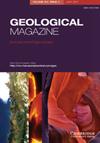Granitic magmatism associated with gold mineralization: evidence from the Baizhangzi gold deposit, in the northern North China Craton
IF 2
3区 地球科学
Q3 GEOSCIENCES, MULTIDISCIPLINARY
引用次数: 0
Abstract
Abstract The relationship between magmatism and gold mineralization has been a topic of interest in understanding the formation of ore deposits. The Baizhangzi gold deposit, located in the northern margin of the North China Craton, is hosted by the Baizhangzi granite (BZG) and provides a case to evaluate the relation between granite and gold mineralization in Late Triassic. In this study, we present petrography, bulk geochemistry, zircon U-Pb isotope and trace elements data, as well as major elements of biotite and plagioclase for the BZG to evaluate the petrogenesis and link with gold mineralization. The BZG comprises biotite monzogranite, biotite-bearing monzogranite and monzogranite (BZGs). Zircon U-Pb geochronology shows that all the granitoids of BZGs were coeval with a formation age of 232 Ma. The granitoids, with high SiO2, Al2O3 and Sr, while low Y and Yb, show adakitic affinity. They are enriched in LILFs (e.g., Rb, Ba, Th, U and Sr) and LREEs, while depletion in HFSEs (e.g., Nb, Ta, P and Ti). The geochemical and mineral chemical data suggest that the granitoids have experienced the fractional crystallization of biotite + plagioclase + K- feldspar + apatite. Crystallization temperature is estimated as ca. 700°C, and pressure is between 0.71 kbar and 1.60 kbar. The monzogranite shows higher values of logfO2, △FMQ and △NNO than the biotite-bearing monzogranite, ranging from −19.76 to −11.71, −4.93 to +3.67 and −5.48 to +3.11, respectively. The fractional crystallization, together with high fO2, K-metasomatism and low evolution degree, provided favourable conditions for gold mineralization.与金矿化有关的花岗质岩浆作用——来自华北克拉通北部白堡子金矿床的证据
摘要岩浆作用和金矿化之间的关系一直是理解矿床形成的一个有趣的话题。白堡子金矿床位于华北克拉通北缘,以白堡子花岗岩为主体,为评价晚三叠世花岗岩与金矿化的关系提供了一个实例。在本研究中,我们提供了岩石学、本体地球化学、锆石U-Pb同位素和微量元素数据,以及黑云母和斜长石的主要元素,以评估BZG的岩石成因及其与金矿化的联系。BZG包括黑云母二长花岗岩、含黑云母二短花岗岩和二长花岗岩(BZG)。锆石U-Pb年代学表明,BZG的所有花岗岩都是同时代的,形成年龄为232Ma。这些花岗岩具有较高的SiO2、Al2O3和Sr,而较低的Y和Yb,表现出阿达克岩亲和性。它们在LILF(例如,Rb、Ba、Th、U和Sr)和LREE中富集,而在HFSE(例如,Nb、Ta、P和Ti)中贫化。地球化学和矿物化学资料表明,花岗岩类经历了黑云母+斜长石+钾长石+磷灰石的分离结晶。结晶温度估计约为700°C,压力在0.71 kbar至1.60 kbar之间。二长花岗岩显示出较高的logfO2值,△FMQ和△NNO比含黑云母的二长花岗岩的NNO分别为−19.76至−11.71、−4.93至+3.67和−5.48至+3.11。分级结晶,加上高fO2、钾交代作用和低演化程度,为金矿化提供了有利条件。
本文章由计算机程序翻译,如有差异,请以英文原文为准。
求助全文
约1分钟内获得全文
求助全文
来源期刊

Geological Magazine
地学-地球科学综合
CiteScore
4.70
自引率
0.00%
发文量
111
审稿时长
3 months
期刊介绍:
Geological Magazine, established in 1864, is one of the oldest and best-known periodicals in earth sciences. It publishes original scientific papers covering the complete spectrum of geological topics, with high quality illustrations. Its worldwide circulation and high production values, combined with Rapid Communications and Book Review sections keep the journal at the forefront of the field.
This journal is included in the Cambridge Journals open access initiative, Cambridge Open Option.
 求助内容:
求助内容: 应助结果提醒方式:
应助结果提醒方式:


